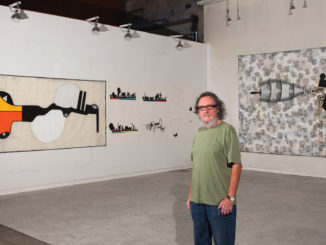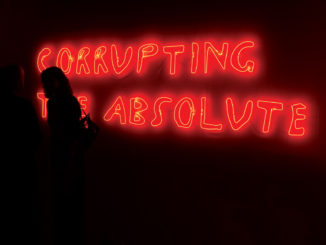 The three-story, 30,000 square foot structure that houses the Carlos and Rosa De La Cruz collection opened to an impressive turnout of visitors during Art Basel Miami Beach. Now that the crowds have dispersed and the dust has settled a bit on the brand-spankin’ new space, its presence in our local arts landscape is sure to bring more attention to the arts in Miami, a place blessed with a few world-class art collections that rival other big art cities. Designed by John Marquette, the space itself is open and clean, and flooded with the unmistakable natural Miami light. Inside lives the art collected by Carlos and Rosa de la Cruz. The space is not a museum, but rather an extension of the couple’s home, which opens each year to the public during Art Basel Miami Beach. Now the De La Cruzes have created a place where the public can view their collection, free of charge, on a regular basis.
The three-story, 30,000 square foot structure that houses the Carlos and Rosa De La Cruz collection opened to an impressive turnout of visitors during Art Basel Miami Beach. Now that the crowds have dispersed and the dust has settled a bit on the brand-spankin’ new space, its presence in our local arts landscape is sure to bring more attention to the arts in Miami, a place blessed with a few world-class art collections that rival other big art cities. Designed by John Marquette, the space itself is open and clean, and flooded with the unmistakable natural Miami light. Inside lives the art collected by Carlos and Rosa de la Cruz. The space is not a museum, but rather an extension of the couple’s home, which opens each year to the public during Art Basel Miami Beach. Now the De La Cruzes have created a place where the public can view their collection, free of charge, on a regular basis.
The pieces on exhibit range from Felix Gonzalez-Torres’ light strands Untitled (America #3), Jim Hodges’ Where are we now?, a 24 foot long curtain made of artificial flowers strung together, to a body of seminal work by Ana Mendieta, including the video Untitled (Creek #2) that features Mendieta floating nude in a stream of water. Painting, sculpture, mixed media, video, and installation pieces all find their place within the De La Cruz collection, and create a well-balanced and beautifully put-together survey of the couple’s passion for art. Recently, Rosa de la Cruz shared her views on collecting and what she feels makes a house a home for her and her husband’s art collection with Miami Art Guide.
MAG: How did you and your husband begin collecting art? Is there a particular piece that inspired you to begin your collection?
De La Cruz: I do not think that this was a planned decision nor there was a particular piece that inspired us to collect. Around 20 years ago we started acquiring works for our house without ever dreaming that this would become a collection. The first work we acquired is a beautiful blue painting by Rufino Tamayo called The Stargazer. With time we started visiting galleries and looking at contemporary art. One of the first works we acquired for our collection is a huge light piece by the Chilean artist Alfredo Jaar.
MAG: You’ve mentioned that the new space at 41st Street will have an educational component to it. What are some of the educational projects you have in the works?
De La Cruz: I think it is very important for this space to have an educational component. An art space should serve its community, especially our art students. Even though we just opened weeks ago, Ibett Yanez, the director, and I are already organizing the program for 2010. In our first lecture or round table, we would like to discuss how the art world today increasingly calls for interdisciplinary collaboration between art, architecture, design and urban planning. The Miami-Dade Public School’s art teachers are also having a one-day workshop in January at the space based on our collection’s large holding of Ana Mendieta’s work.
MAG: Besides the presence of Art Basel Miami Beach, why do you think Miami has become such a hotbed for contemporary art?
De La Cruz: I would not use the word hotbed. Miami is a city of the future and I think that is the reason why Basel chose us as their only venue in the USA. We need to strengthen our cultural institutions by being more involved, gain knowledge and raise the level of art awareness.
MAG: You’ve mentioned that you believe that collections “have a soul”. Can you elaborate on where you feel the “soul” of the De La Cruz collection lies?
De La Cruz: For example the Prado Museum collection has a soul. When you enter the Prado you immediately feel that there is a spiritual coherence in that collection – the reason is because once that collection was the Royal Family’s private collection, and one feels the strong relationship that the family had with many of the painters like Rubens, Velazquez and Goya. I think that the soul is the spirit of a collection that helps you group works not just as mere objects but with a certain feeling that it is very difficult to explain. For the opening of the new space we invited many of the artists to come and install their works. For both Carlos and I, it was important to inaugurate our space with the works by Ana Mendieta and Felix Gonzalez-Torres.
MAG: As someone who has lived in Miami for many years, is there a part of or an element of Miami outside of the usual that you wish visitors would be able to see more easily?
De La Cruz: I love the Design District. The reason why we built our new space there is because this is one of the nicest areas developing in Miami. There are so many nice design stores, boutiques, great restaurants, and you can walk around the neighborhood. You can see more and more how visitors from here and out of town like to come to this area.
MAG: Can you share with us any upcoming local artists who will be showing work in the project space?
De La Cruz: The project room opened with an installation by Viking Funeral. We hope to have four projects per year and are presently organizing the program.
MAG: When you add a piece to your collection, is it gut instinct that drives you to acquire it? Do you have consultants or curators that advise you, or is it a mix of both?
De La Cruz: I do not believe in falling in love with an artwork by gut instinct. I always tell young collectors “do your homework”. It is important to travel to art fairs, biennials and visit exhibitions to acquire knowledge. I try to be as informed as possible by traveling to different places in Europe, Latin America and the USA. This summer Carlos and I went to the Venice Biennial and later to Art Basel in Switzerland. We also visit the Armory Show in New York, Frieze Art Fair in London and smaller biennials like the one in Lyon, France or Berlin. I have always considered traveling important because this allows me to spend time with curators and collectors, and ask for advice to gain knowledge. The eight years with The Moore Space, the alternative space that I founded with Miami collector Craig Robins, were great because this space gave me the opportunity to work with many artists and look at the art being produced today.



Be the first to comment